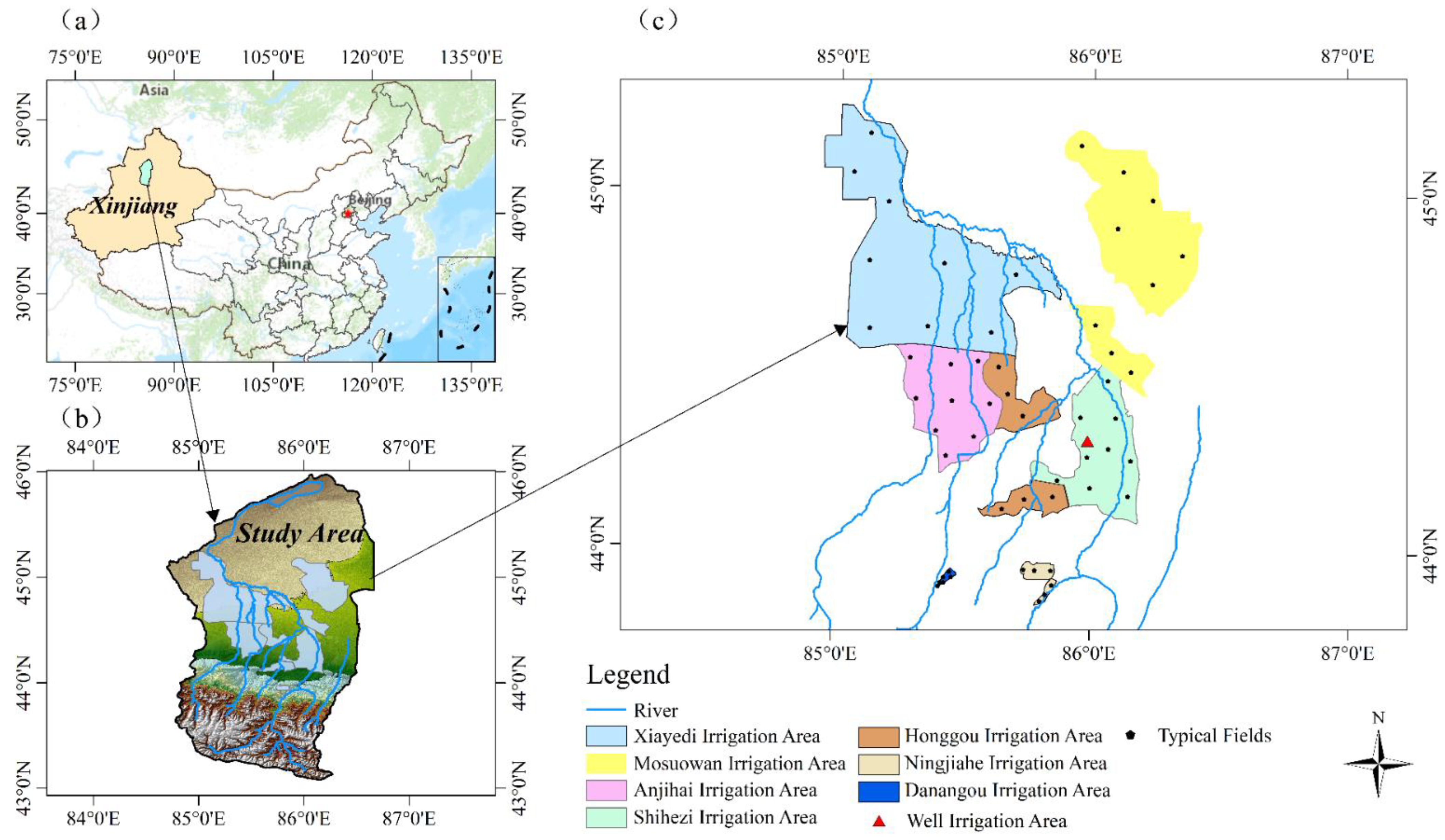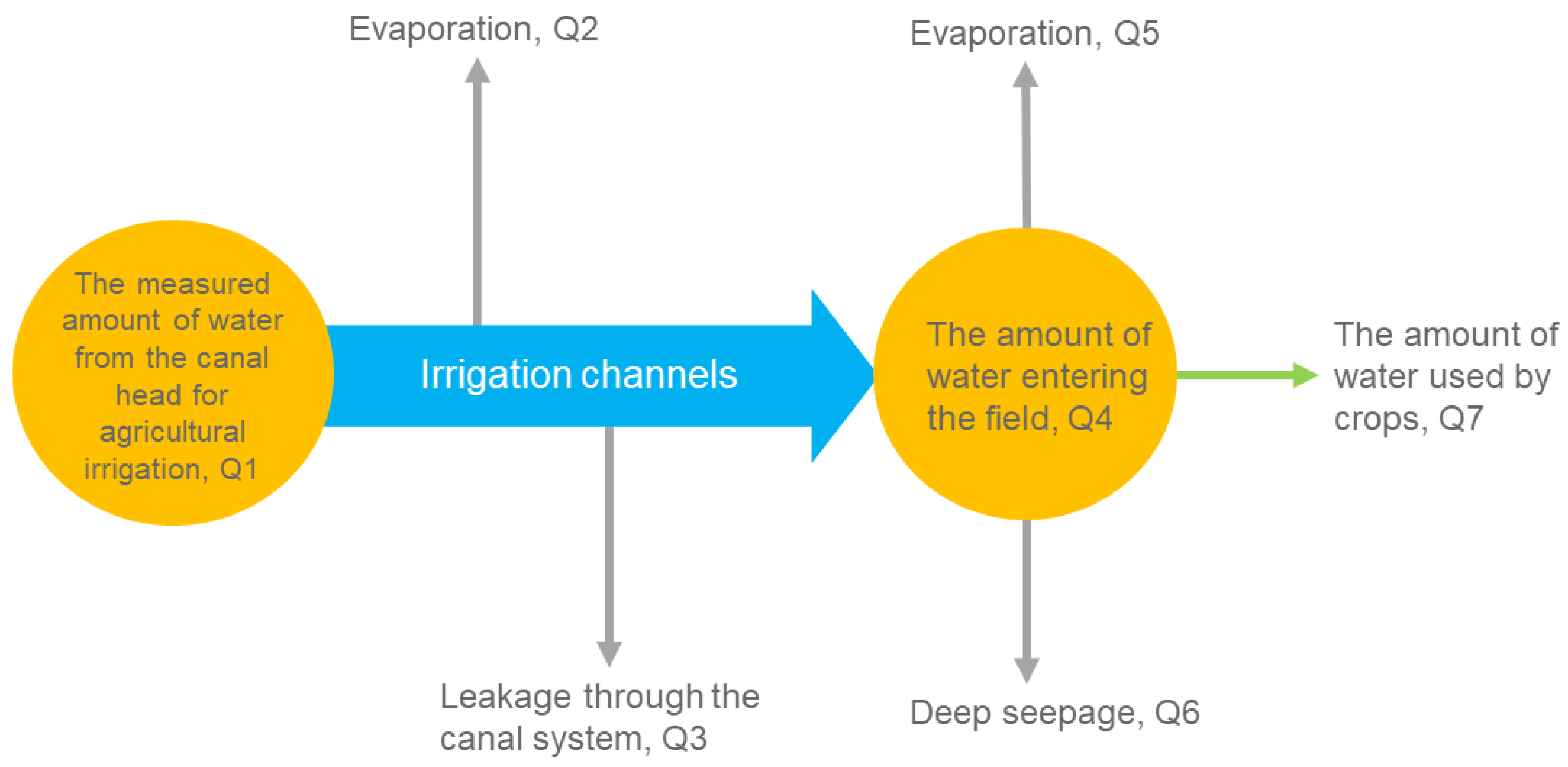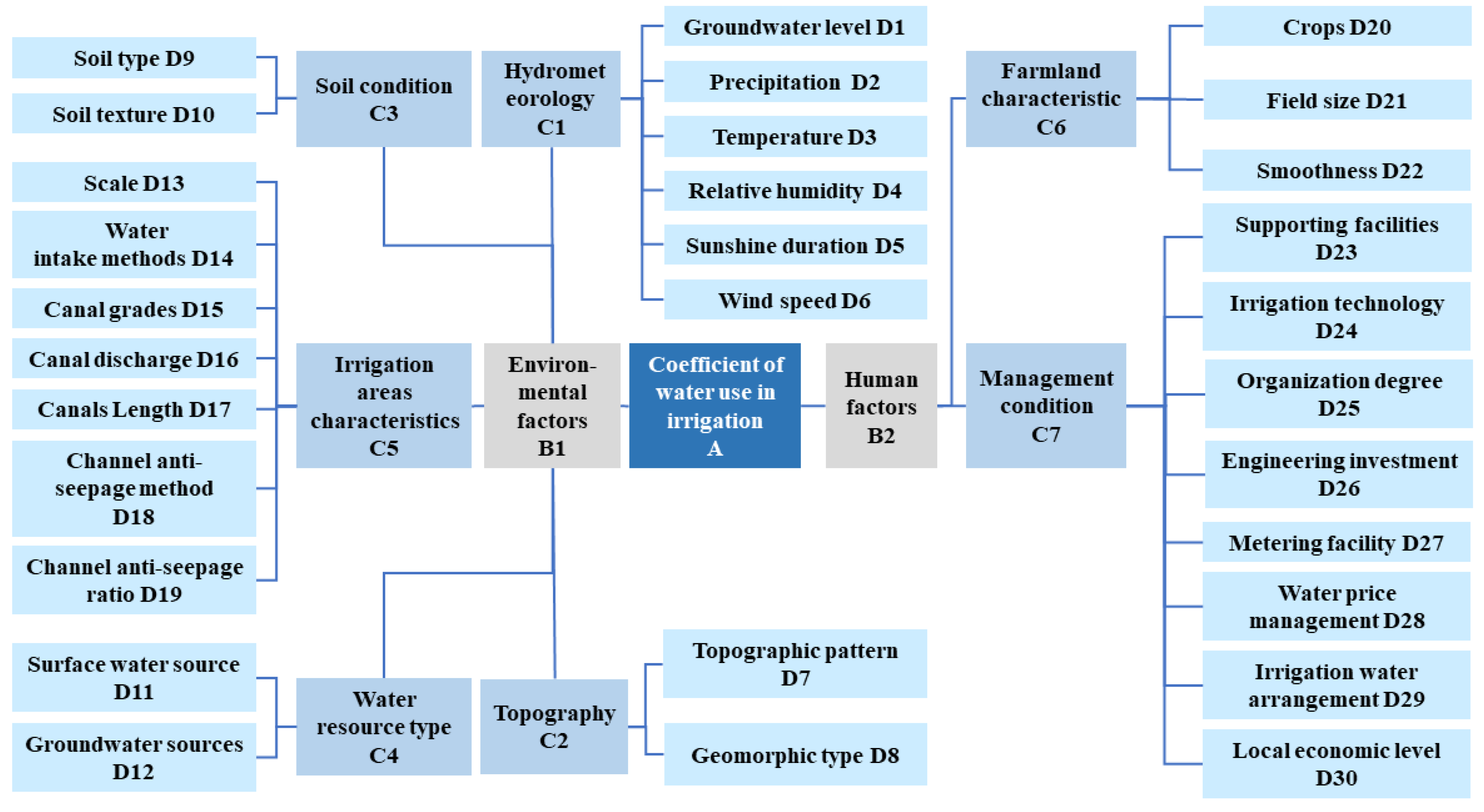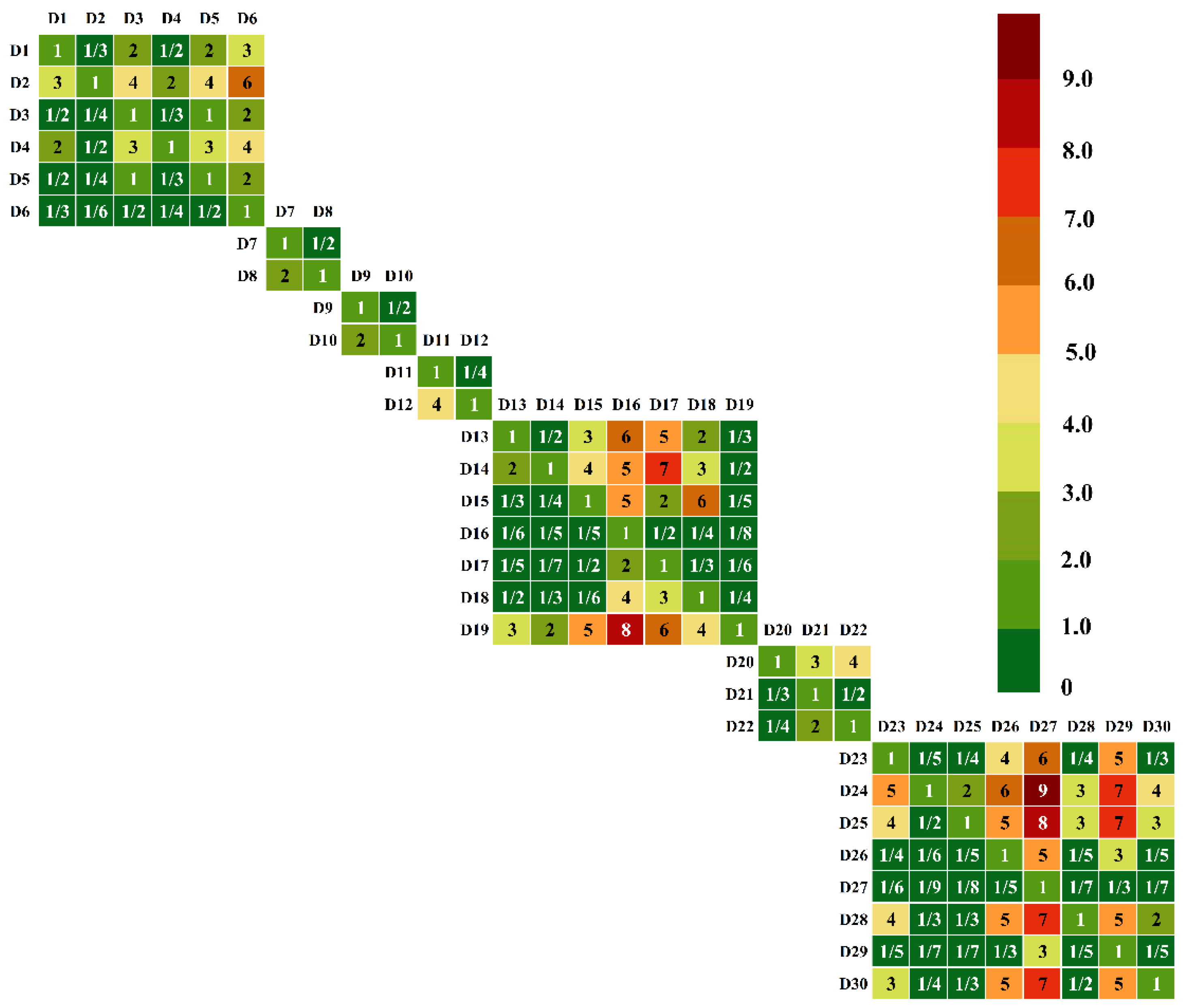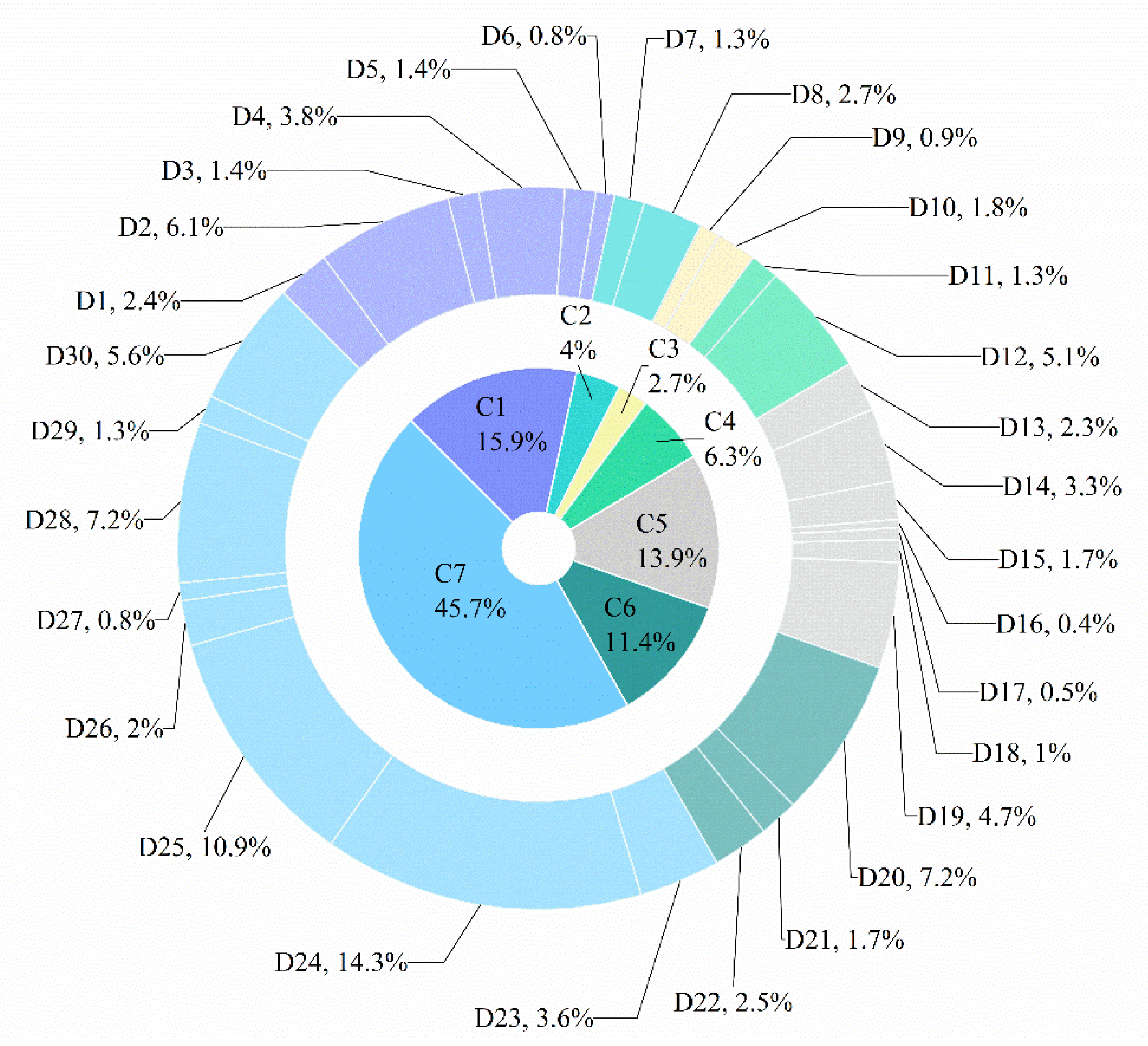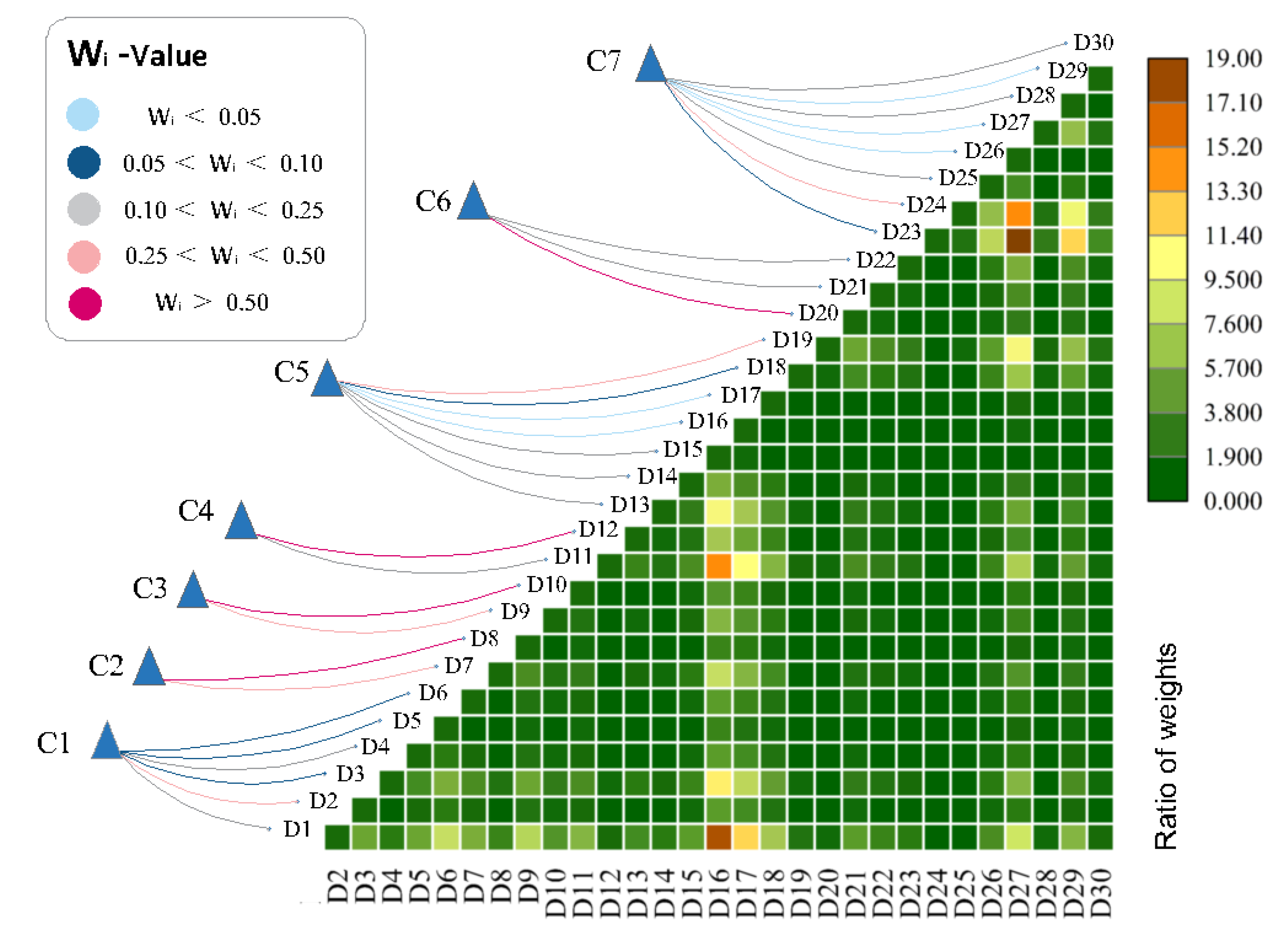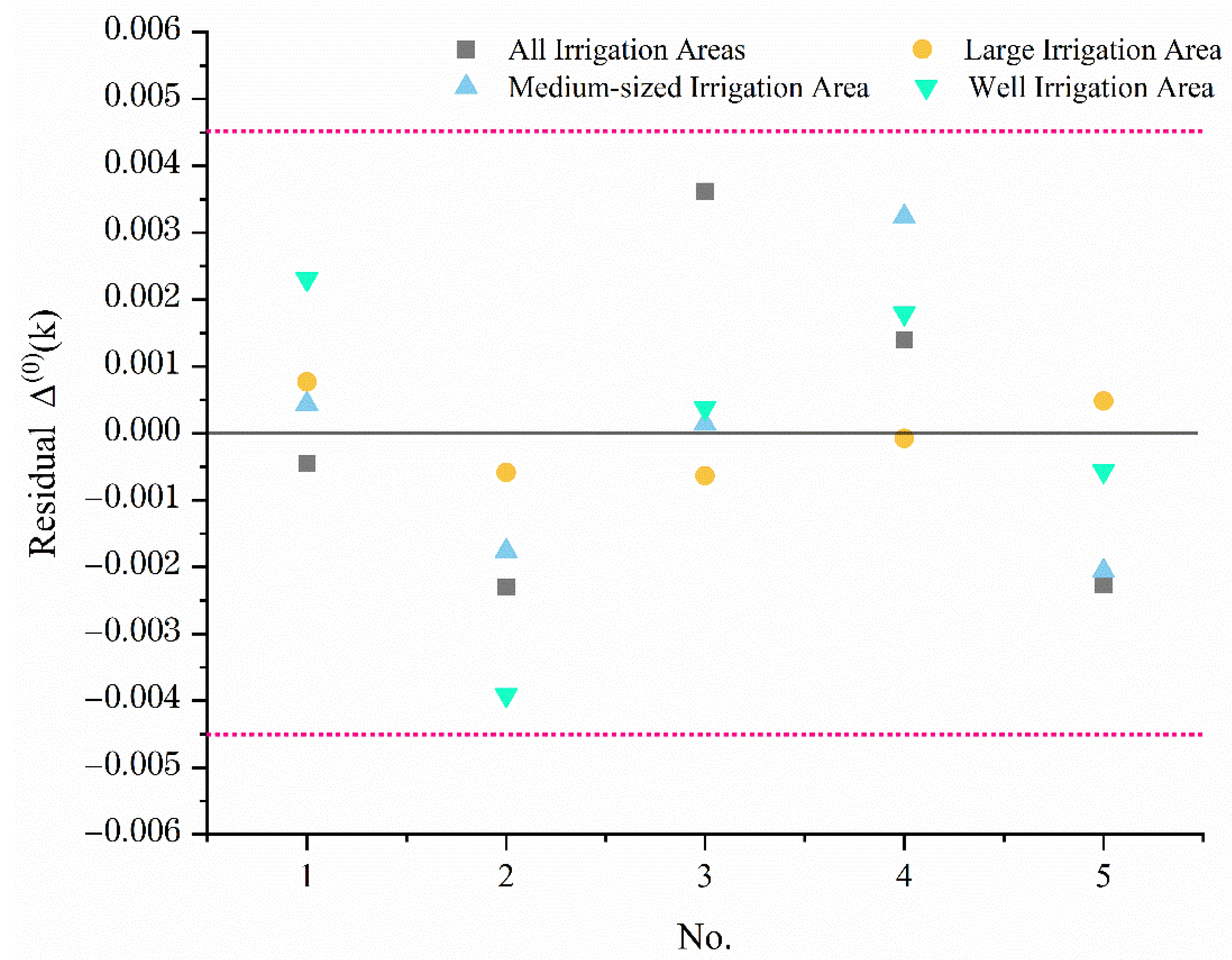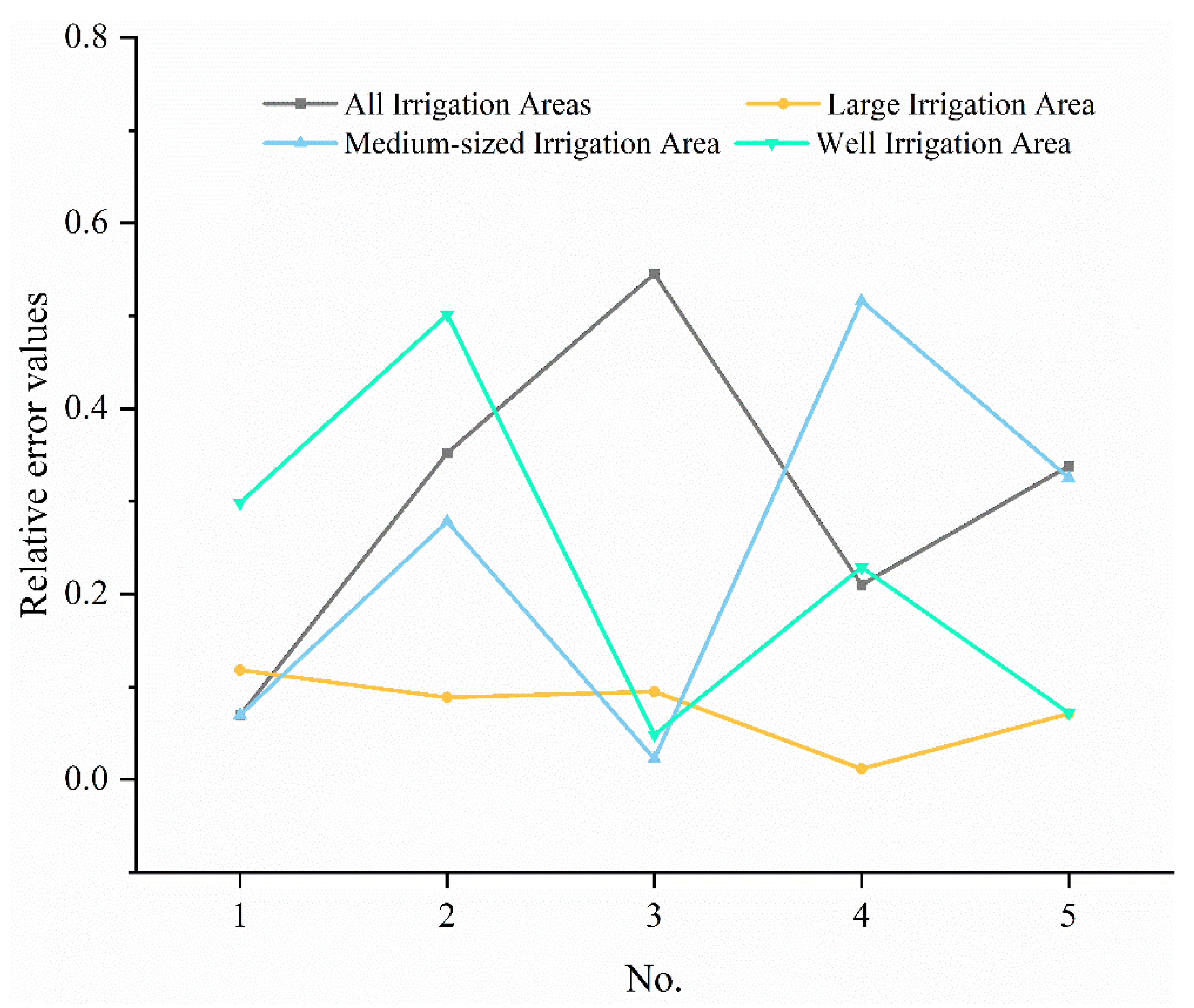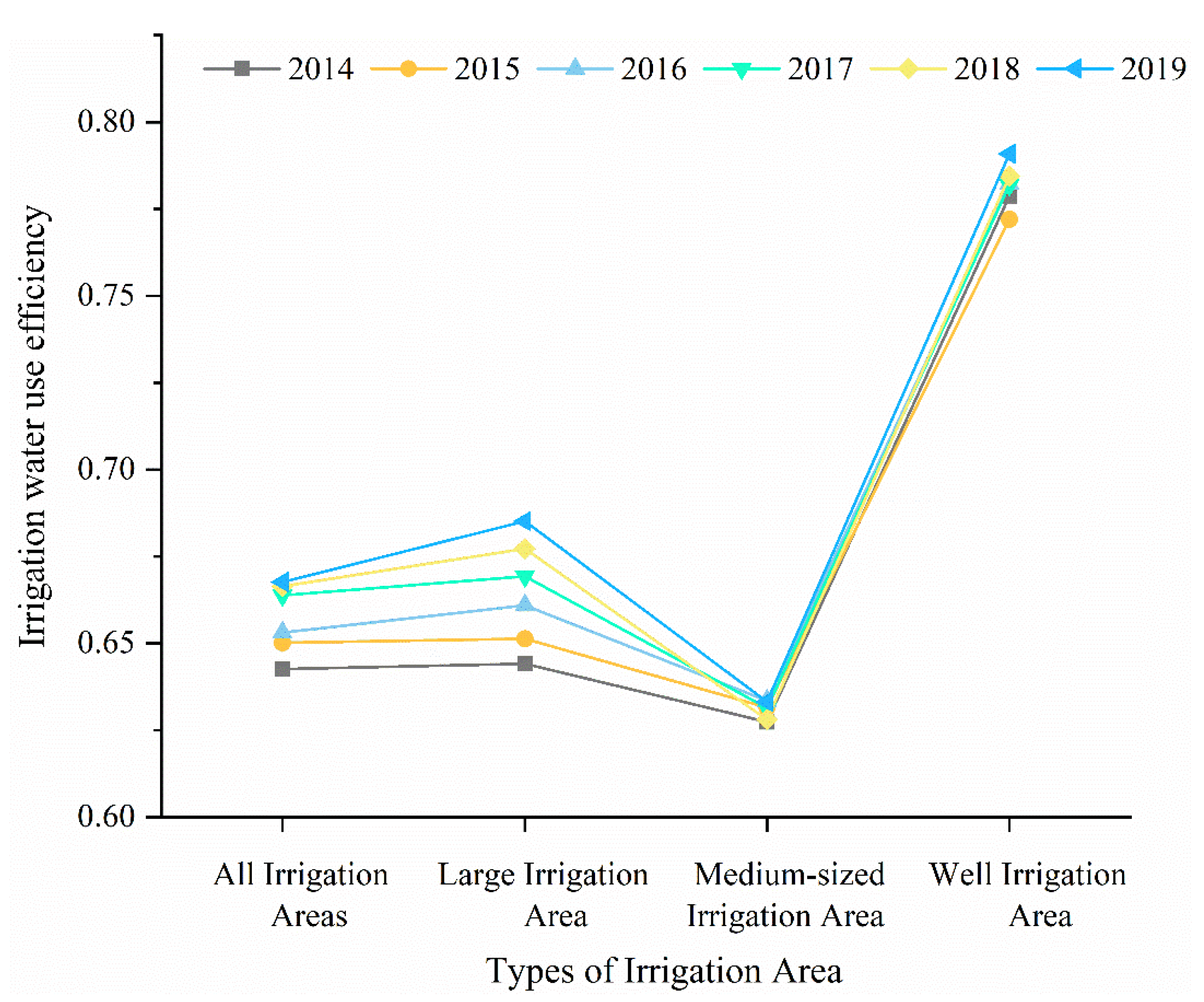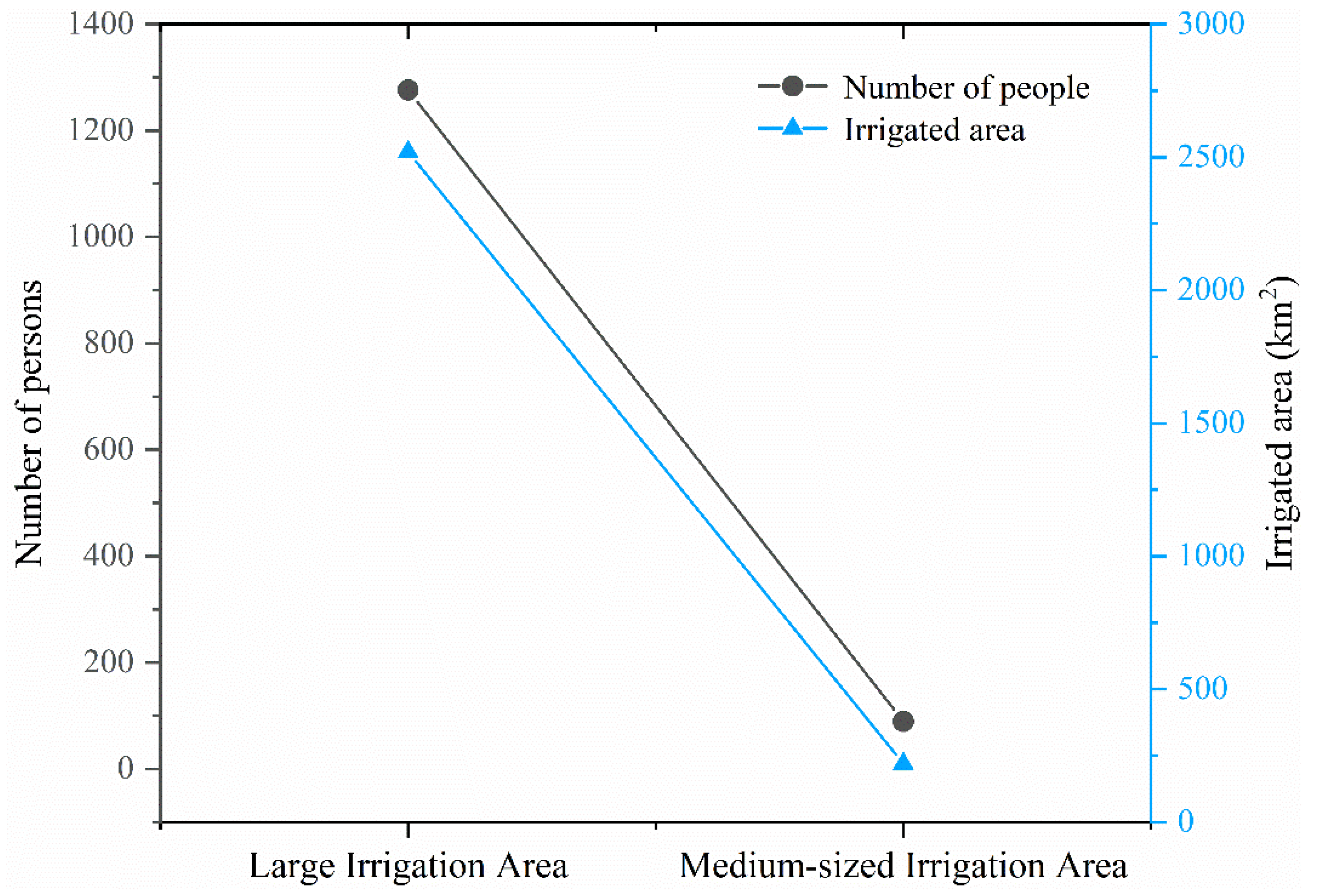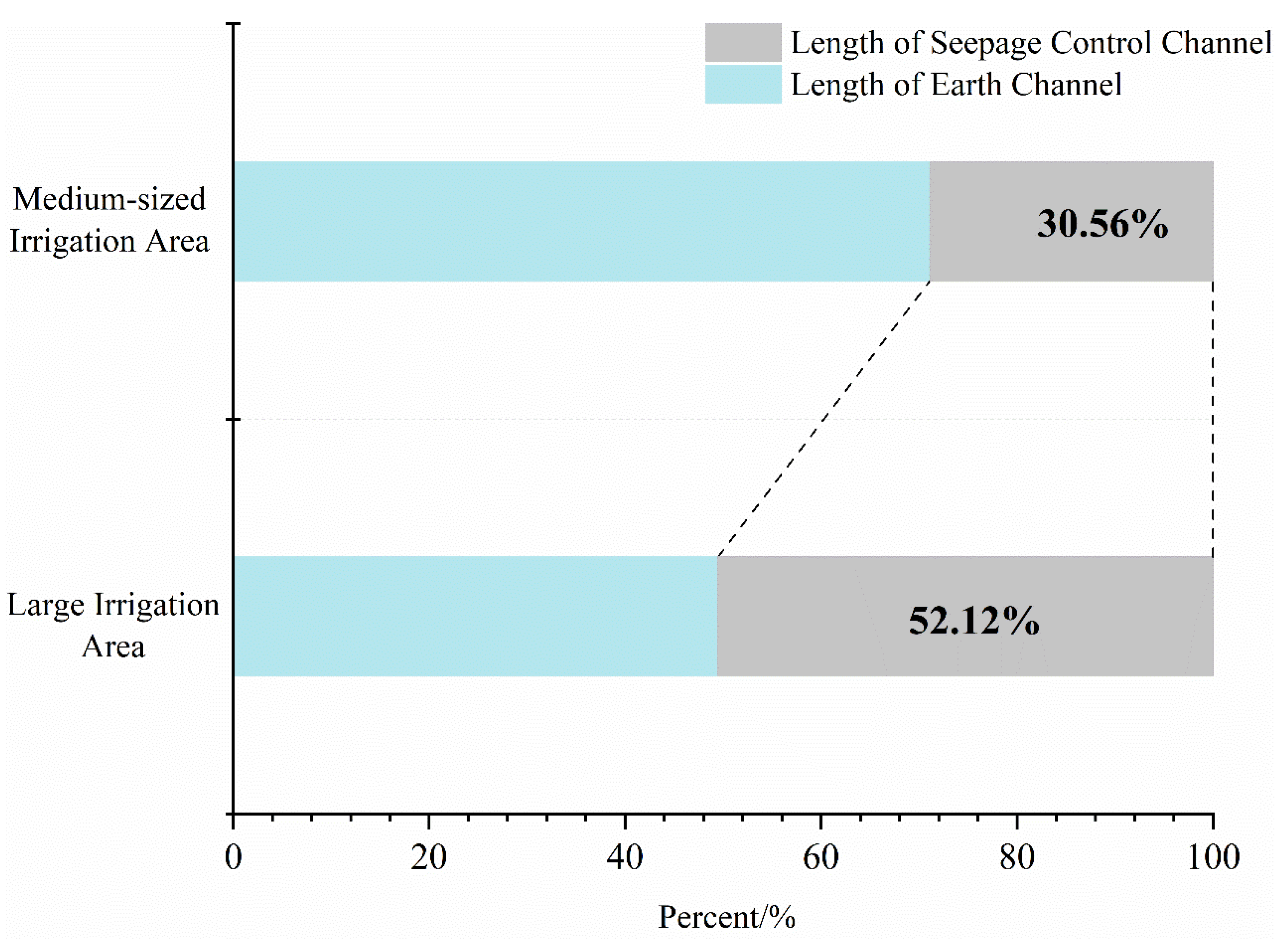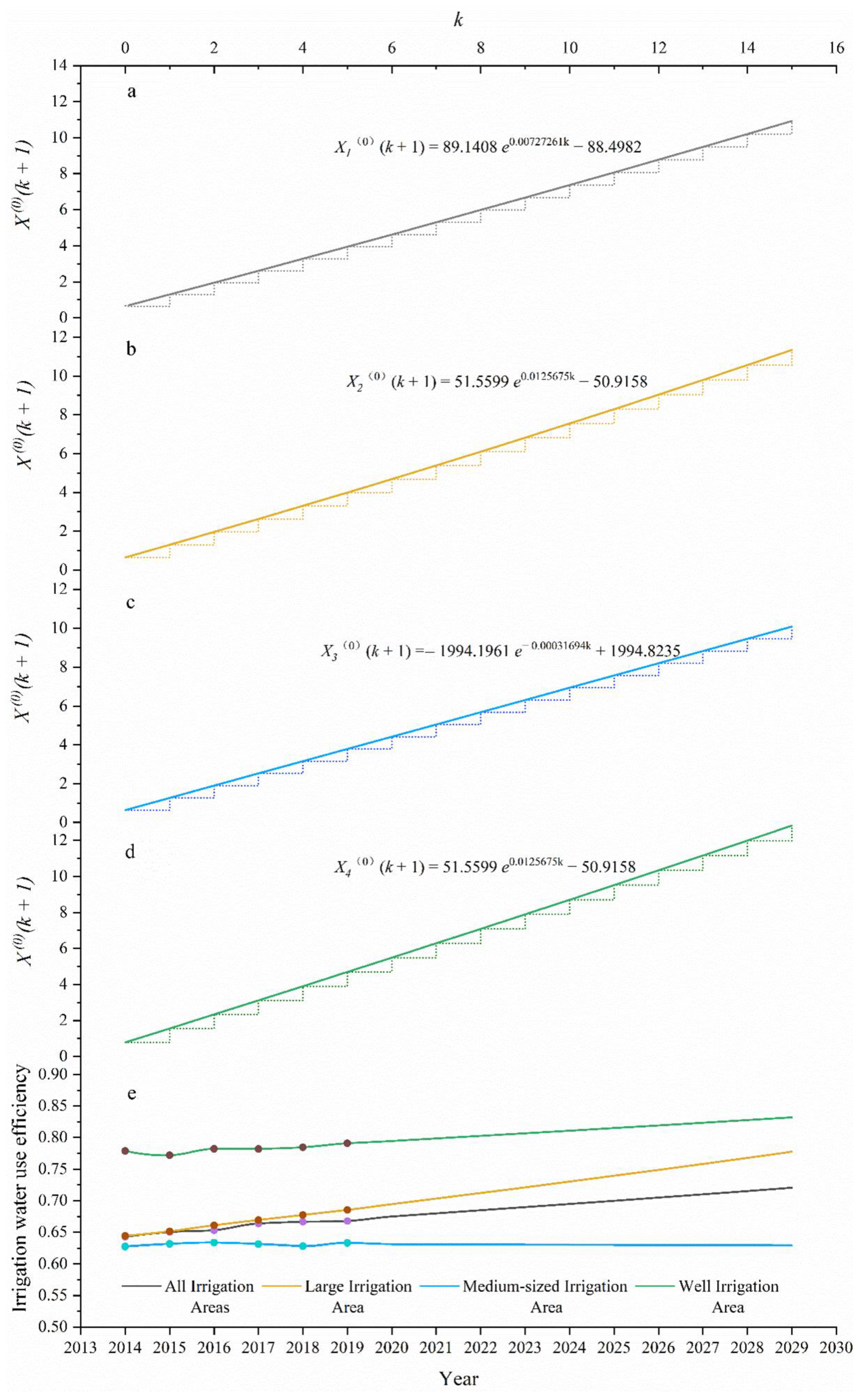1. Introduction
Global water demand has drastically increased over the past fifty years, causing problems such as the overexploitation of water resources and imbalance in supply and demand. In arid and semi-arid regions, irrigation water is a critical factor for agricultural development [
1]. Water shortages have affected agricultural production [
2]. Governments of various countries are trying to ensure the increase of agricultural production through comprehensive and expensive irrigation projects. Water has become an essential strategic resource that affects regional development and stability. Agricultural water accounts for 70% of global freshwater extraction, and the proportion in some parts of the world is as high as 90% [
3]. The International Irrigation and Drainage Commission defines irrigation efficiency as the ratio of the actual use of water by a crop to the total water inflow from the head of the canal [
4]. As a large agricultural country, China’s utilization coefficient of farmland irrigation water has been maintained at approximately 0.5 for many years, which is far lower than 0.7–0.8 achieved by developed countries.
Research on the factors that affect the effective utilization coefficient of irrigation water has been ongoing. The effective utilization coefficient of irrigation water refers to the ratio of the amount of water that is nonreusable to the water use system to the total amount of water from the head of the main canal [
5]. Hussain et al. [
6] pointed out that regional resources, agricultural products and technologies, and water supply prices are the most important factors that affect the effective utilization coefficient of irrigation water through research on large-scale irrigation areas. Rodríguez-Díaz et al. [
7] applied benchmark testing and multivariate data analysis techniques, such as cluster analysis, to nine irrigation areas in Andalusia, Spain and found that the unit water use cost of farmers has a significant relationship with the effective utilization coefficient of irrigation water. Xiong Jia [
8] studied the relationship between irrigation water utilization rate and natural and human-made factors and suggested that the effects of these factors on the effective utilization coefficient of irrigation water are interrelated. Based on analyzing the traditional measurement method used for the irrigation water utilization coefficient, Xu et al. [
9] suggested that the scales of irrigation areas, channel levels, antiseepage measures, and irrigation technology levels are the main factors that affect the effective utilization coefficient. Liu et al. [
10] found that socioeconomic development level (GDP) and effective irrigation area have significant impacts on the effective utilization coefficient of irrigation water. Qin et al. [
11] evaluated the agricultural water-saving potential of China’s Beijing–Tianjin–Hebei region by combining multiple factors and the effective use of irrigation water. Agricultural water saving can also be achieved through improvements in irrigation technology and management [
4,
12]. There are many reports on the factors affecting the efficiency of irrigation water use; however, research on the degree of influence of each factor on the effective utilization coefficient of irrigation water is lacking.
China has the largest drip irrigation area under mulch on farmland in the world [
13]. The Xinjiang Province is the birthplace of China’s drip irrigation technology under mulch, and it has developed irrigated oasis agriculture techniques over many years. Irrigation technology and management experience are relatively advanced, representative, and typical in Xinjiang. At the same time, Xinjiang is located in an inland arid area, and water resources are relatively scarce. Irrigation accounts for 89.4% of the total water consumption of the province [
14]. The contradiction between water supply and demand in Xinjiang has become increasingly prominent, and the agricultural water-saving potential is huge. Related research has also been carried out in this region. For instance, Geng and Song [
15] used the Tobit model to analyze the influencing factors of irrigation water efficiency in the cotton fields of Xinjiang. Wei [
16] carried out calculations on agricultural water use efficiency in various prefectures in Xinjiang and explored the influencing factors of agricultural water use efficiency. However, the effective utilization coefficient of irrigation water in the large-scale Shihezi irrigation district in Xinjiang was higher than that of other medium-sized irrigation districts, which is not consistent with many previous research results [
17,
18,
19,
20,
21,
22]. Therefore, to analyze and identify the factors that significantly affect the utilization coefficient of irrigation water, this study investigated all irrigation areas in the Shihezi district of Xinjiang. We used the analytic hierarchy process to calculate the weight of each factor, and the effective utilization coefficient of irrigation water from 2014 to 2019 to predict the future trend of irrigation water efficiency using the grey model. The outcomes of this research are of practical significance and can serve as a reference for government authorities to make scientific decisions that promote the development of water-saving irrigation.
2. Materials and Methods
2.1. Study Area
The study area (
Figure 1) is located at the southern edge of the Junggar Basin in the middle section of the northern slope of the Tianshan Mountains in Shihezi City, Xinjiang, China. It belongs to the Manasi River Basin and is the central area of the economic belt on the northern slope of Tianshan Mountains in Xinjiang. It has an arid continental climate with scarce rainfall. The average annual rainfall during 1965–2018 was 200.5 mm. The rainfall mainly occurs during spring and summer, accounting for 67% of the annual precipitation. Evaporation is extensive, with an annual average of 1500 mm, suggesting a typical desert oasis and irrigated agricultural area. The Manas River is the primary source of water and it is mainly supplied by alpine snowmelt and precipitation. The primary sources of irrigation are river, spring, and well water.
The total irrigated area in the study area is 3094.4 km2 and the cultivated land area is 2740 km2, 93% of which uses drip irrigation under film mulch. Large-scale irrigation areas (irrigated area > 200 km2) include the Mosuowan, Shihezi, Xiayedi, and Anjihai. Medium-sized irrigation areas (33.3 km2 > irrigation area > 200 km2) include Honggou, Ningjiahe, and Da’nangou. Shiyanchang is an irrigation area supplied by wells. The total length of channels in the region is 3349.15 km (of which 2815.46 km is impervious) with a flow rate of more than 0.2 m3/s.
2.2. Data Sources
Statistical data collected by the district authorities in all large and medium-sized irrigation districts and well irrigation districts of Shihezi, Xinjiang from 2014 to 2019 were used for this study. The “calculation method for canal head and tail water” was used to investigate the effective utilization coefficient of irrigation water. Crops covering a planting area of more than 10% of the total irrigation area were selected as typical crops. Three typical fields were selected in each of the upper, middle, and lower reaches of the large-scale irrigation area (a total of 9 typical fields). Three typical fields were selected in the upstream and downstream of the medium-sized irrigation area (a total of 6 typical fields). Four typical fields were selected in the well irrigation area. As the only common crop in each irrigation area is cotton, the planned wet layer was kept at 0.6 m, and samples were drawn at 10-cm depth intervals with a total of 6 layers. Stainless steel cores were used to drill and collect approximately 25 g of soil samples within 48 h before and after each irrigation period. The collected soil samples were stored in an aluminum box (60 mm in diameter, 30 mm in height, and M
1 in mass). After the boxes were wrapped with tape, the surface was wiped clean and the aluminum box was sent to the laboratory. There, the box was weighed using a balance with an accuracy of ±0.01 g, and the weight was noted as M
2. The soil sample was heated in an oven at 105 °C for 12 h to a constant weight, and this was recorded as M
3. The soil moisture content was calculated as follows:
Based on the change in the planned wet layer’s soil moisture content before and after typical field irrigation, the net irrigation water consumption per unit area was calculated using the formula:
where
is the net irrigation water consumption per unit area in the field (m
3/ha),
H is the designated moist layer of soil (m),
γ is the bulk density (t/m
3),
θg1 is the soil water content before irrigation (%), and
θg2 is the soil water content after irrigation (%).
The sum of all
values was calculated to determine the annual net irrigation water consumption per unit area in a typical field
The net irrigation water consumption per unit area of a typical field
was calculated as follows:
where
is the irrigation area of the typical field (ha) and
m is the number of typical fields.
The net irrigation water use
(Q7 in
Figure 2) was calculated as follows:
where
is the number of typical irrigation areas.
The gross irrigation water use
(Q1 in
Figure 2) was monitored by the local water conservancy department based on the actual water taken from the water source by the irrigation area. The coefficient of water irrigation
was calculated as follows:
Other relevant data for this research were procured from the Eighth Division Shihezi City Water Conservancy Statistical Yearbook. The indicator system composition principle was put forward based on data review, expert consultation, field investigation, comprehensive analysis, and consideration of natural and unnatural conditions. This principle led to a selection that accurately reflected the impact of irrigation water use in various types of irrigation areas and was highly targeted. Thirty representative indicators were used to construct an index system for the prediction of the effective utilization coefficient of agricultural irrigation water (
Figure 3).
2.3. Analytic Hierarchy Process
The analytic hierarchy process is a systematic analysis method that combines quantitative and qualitative approaches. It involves a multiobjective group decision-making process, which decomposes decision-making goals to different levels to form a bottom-up cascade structure [
23]. The indicators are sorted and quantified to form a judgment matrix, and the judgment matrix is checked for consistency, and then the weight is calculated to analyze the correlation and restriction of the hierarchy in the indicator system.
In order to quantify the analysis of A = , i, j = 1, 2, …, n in the matrix, the 1–9 scale method was adopted. The specific values were based on data, systematic analysis, and expert consultation.
Maximum eigenvalue of the matrix
and consistency inspection index (
CI) were calculated as follows:
where
n is the matrix dimension.
The average random consistency index (
RI) was selected according to the matrix’s dimension, and its value is shown in
Table 1.
When CR < 0.1, it is considered that the consistency check passes. Otherwise the value must be reassigned until the check passes.
The index weight of single-level elements was calculated by
where,
Normalization processing followed:
2.4. Grey Model
Suppose that the equal interval time series
has n observations
, which are accumulated to form times,
The sequence after the randomness has been weakened by m times can be obtained by: . If is the mean value of the sequence of , , so .
The differential equation of the whitening grey prediction model GM (1,1) was established according to existing data:
where
a is the evolution parameter and
b is the grey action quantity. According to the principle of least squares, the parameters
a and
b, and the prediction model are obtained through Laplace transform and inverse Laplace transform:
5. Conclusions
This study used the analytic hierarchy process and grey model to analyze the influencing factors of the effective utilization coefficient of irrigation water in typical arid and semi-arid areas where drip irrigation has been adopted. It was found that the presumption of larger irrigation areas exhibiting smaller utilization coefficients of irrigation water is not correct. We have shown that in addition to uncontrollable natural conditions, factors such as irrigation technology, completeness of organization, crop types, water price management, local economic level, and channel seepage prevention rate have a significant impact on the effective utilization coefficient of irrigation water. According to the current development model, the utilization coefficient of irrigation water in all irrigation areas will increase continuously. By 2029, the effective utilization coefficient of irrigation water will reach 0.7204, which is close to the level of developed countries. The market plays a decisive role in the allocation of water resources, and hence, improving the water price formation mechanism could be a core comprehensive reform to improve the utilization of agricultural water.
